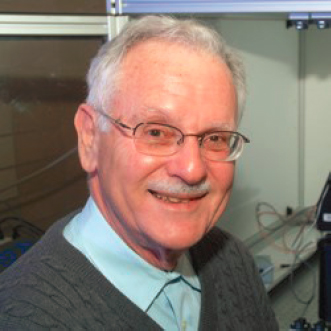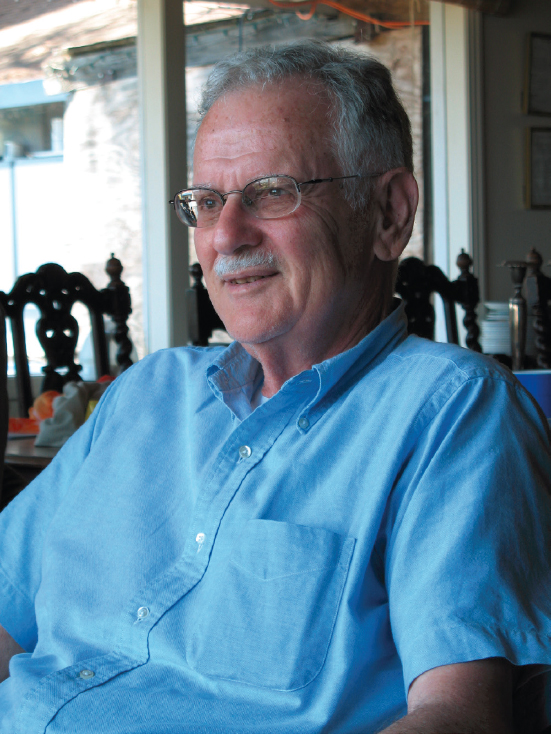

LEON M. KEER
1934–2021
Elected in 1997
“For the application of elasticity to design problems involving contact and fracture.”
BY WEI CHEN, Q. JANE WANG, AND ZDENĚK P. BAŽANT
LEON MORRIS KEER, Walter P. Murphy Professor Emeritus of Civil and Environmental Engineering and Mechanical Engineering at Northwestern University and a leader and prolific researcher on contact and fracture mechanics and tribology, died January 12, 2021, at the age of 86.
Born September 13, 1934, in Los Angeles to William and Sophie Keer, Jewish Ukrainian immigrants, he grew up and attended school in the Beverly/Fairfax area. As a young man he developed a sense of curiosity and wonder about the world that would serve him well for the rest of his life. He had an analytical mind and enjoyed debate as well as tennis and graduated from Fairfax High as the class valedictorian. He enrolled at the California Institute of Technology and received his BS degree in 1956 and his MS degree in 1958, both in mechanical engineering.
In 1956 he married the love of his life, Barbara Davis, and they started a family the next year. Their love for each other
___________________
The authors drew in part from the nomination for Leon Keer’s Mayo D. Hersey Award and from a tribute written by his wife Barbara, “Professor Leon Keer – A Life Well Lived,” which includes delightful photos (https://splashmags.com/index.php/2021/01/24/professor-leon-keer-a-life-well-lived/#gsc.tab=0).
and their growing family kept him grounded as he advanced professionally.
Leon initially worked as a member of the technical staff at Hughes Aircraft Company (1956–59) but, feeling the pull of academia, left to pursue his doctorate at the University of Minnesota. He studied with Lawrence E. Goodman and received his PhD in aeronautics and engineering mechanics in 1962.
As a graduate student, he read Theoretical Elasticity by Alfred E. Green and Wolfgang Zerna. He did not fully understand it, but thought he might if he studied with Professor Green. His curiosity led him to a very productive period (1962–63) as a NATO Postdoctoral Fellow at the University of Newcastle upon Tyne, in England, where he worked closely with Green on elasticity.
Back stateside, Leon spent a year as a preceptor at Columbia University and then joined the Northwestern University faculty in 1964 as an assistant professor in civil engineering. He remained there for more than 55 years. He was promoted to associate professor in 1966, professor in 1970, and named Walter P. Murphy Professor of Civil Engineering in 1994. He served as associate dean for research and graduate studies (1985–92), during which time the school’s graduate ranking improved to 13th in the nation. He also chaired the Department of Civil Engineering (1992–97) and was director of the university’s Center for Surface Engineering and Tribology (CSET) beginning in 1998. He served twice as chair of the Northwestern University Chapter of Sigma Xi (1976–77, 1987–88).
He published nearly 400 scholarly articles on elasticity, fracture mechanics, contact mechanics, and tribology, but his proudest academic legacy was his 55 doctoral students and 22 master’s students.
Leon was known for his collaborative support of research both at the university and internationally, thanks to his broad network of former students and colleagues around the world. At Northwestern, he maintained long-term collaborations with Herbert S. Cheng on tribology, Morris E. Fine on solder material development, Yip-Wah Chung and Kornel Ehmann
on multilayer coating design, and one of the authors (QJW) on computational contact mechanics. Under his leadership of CSET, and with the help of several Northwestern colleagues, the center received an Integrative Graduate Education and Research Traineeship (IGERT) Award from the National Science Foundation in 2001.
Leon was particularly well known for several areas of research: with Lawrence E. Goodman on the elastic contact problem of a sphere indenting a cavity with a slightly larger radius, which extended the Hertz contact theory to allow the contact length to be a significant fraction of the size of the contacting spheres1; with Michael Bryant on the Cattaneo-Mindlin seminal solution for contacting elastic spheres subjected to a tangential load that is too small to cause gross sliding, applied to ellipsoidal bodies and other engineering applications2; on the Mindlin field for a concentrated force at an interior point of a half-space, or the Rongved field for a force at a point within one of two joined half-spaces, setting up integral equations for three-dimensional crack problems; with Nasser Ahmadi and Toshio Mura on a technique to calculate the subsurface elastic strain in a half space3; with Igor Polonsky on solving rough-surface contact problems with the conjugate gradient method4; and on the singular stress field near the tips of conical notches.5
___________________
1 Goodman LE, Keer LM. 1965. The contact stress problem for an elastic sphere indenting an elastic cavity. International Journal of Solids and Structures 1(4):407–15.
2 Bryant MD, Keer LM. 1982. Rough contact between elastically and geometrically identical curved bodies. Journal of Applied Mechanics 49(2):345–52.
3 Ahmadi N, Keer LM, Mura T. 1983. Non-Hertzian contact stress analysis for an elastic half space—normal and sliding contact. International Journal of Solids and Structures 19(4):357–73.
4 Polonsky IA, Keer LM. 1999. A numerical method for solving rough contact problems based on the multi-level multi-summation and conjugate gradient techniques. Wear 231(2):206–19.
5 Bažant ZP, Keer LM. 1974. Singularities of elastic stresses and of harmonic functions at conical notches or inclusions. International Journal of Solids and Structures 10(9):957–64.
The hallmark of Leon’s research was his successful development of useful, exact, analytical solutions to a number of difficult and technically crucial problems, such as crack propagation in rolling contact fatigue, edge effects in the flanging problem of wheel-rail contact and demonstration of their influence on life prediction and design, the influence of service loading on shell growth in rails, life prediction of gears and bearings, and the treatment of hydraulic fracture growth for reservoir simulation.
His work also impacted biomechanics and geophysics. His analysis provided the basis for interpreting an indentation test, still in use, that enhanced understanding of testing procedures for articular cartilage and was critical in the development of controlled testing procedures. He developed analytical methods to determine whether isolated pressurized cracks intersect joints, by using elasticity to model the process of hydraulic fracturing. In the area of quantitative nondestructive evaluation, he theoretically predicted resonance effects on a crack near a free surface.
In addition to his publications, collaborations, and analytical techniques, Leon served the research community as an associate editor for mechanics journals, including Elasticity (1977–79 and 1987–89) and Journal of Applied Mechanics (1987–88; technical editor, 1988–92). He was chair of the Transactions Board of Editors of the American Society of Mechanical Engineers (ASME; 1993–97), and president of the American Academy of Mechanics (AAM; 1988–89).
For his extensive contributions Leon received many honors and recognitions. He was a fellow of the John Simon Guggenheim Memorial Foundation (1972), AAM (1983), ASME (1984), Japan Society for the Promotion of Science (1986), American Society of Civil Engineers (ASCE; 1988), and Acoustical Society of America (2002). He received ASME’s Daniel C. Drucker Medal (2004) and Mayo D. Hersey Award (2008) and ASCE’s Raymond D. Mindlin Medal (2011). His collaborative coating work with Chung and Ehmann won the 2002 Innovative Research Award from ASME’s Tribology Division, and he shared the 2014 Captain Alfred E. Hunt Award from
the Society of Tribologists and Lubrication Engineers for his collaborative contact modeling work.6
Leon was highly respected by his colleagues, collaborators, students, and friends. A beloved and esteemed member of Northwestern’s McCormick School of Engineering, he remained an active researcher and collaborator even at age 86.
He is fondly remembered and deeply missed for his contributions to the growing stature of the mechanical engineering department and his consistently positive attitude. Colleagues commented: “In addition to being a giant in elasticity and contact mechanics, Leon was a wonderful human being, who with his wife Barbara provided a warm and welcoming environment for the mechanics group.” “When I was a new faculty member struggling to find my way, Leon took me on as a collaborator and taught me a ton. He was unrelentingly positive, something I’ll never forget. Such a gentleman. He will be missed.” “Our mechanics group stood out because of great scholars like Leon. And more importantly, he was such a great colleague and mentor.” “He…was incredibly supportive of young faculty. He was always at peace with himself, which made him beloved by so many.”
While research was Leon’s academic passion, what he valued most was his family. He cherished his devoted wife Barbara, to whom he was married for 64 years. Those who knew Leon well will remember him fondly with Barbara by his side. He also took great pride in his four children, Trish (Dave), Jackie (Steve), Harold (Amy), and Michael (Cindy). He was blessed with seven grandchildren and six great-grandchildren.
Leon enjoyed art, fine dining, and cool jazz. His wry sense of humor surprised many. He delighted in Monty Python, Tom Lehrer, and the Bonzo Dog Doo-Dah Band. He and Barbara traveled around the world, attending conferences and extending their trips with visits to see friends, colleagues, and former
___________________
6 Wang Z, Jin X, Keer LM, Wang QJ. 2012. A numerical approach for analyzing three-dimensional steady-state rolling contact including creep using a fast semi-analytical method. Tribology Transactions 55(4):446–57.
students. In 2011 they had the unusual opportunity to meet another Leon Keer, a prominent Dutch artist.
Leon’s wish for his 85th birthday was to gather the family together for a weekend, which they did in January 2020. Nobody knew that covid-19 would prevent future gatherings. Leon was very happy with his memories of that special birthday and grateful for the time spent together. He said of his life, “I feel very lucky,” and shared some wisdom acquired over the years:
To some extent, learning has to come spontaneously…. The world is an amazing thing and you have to have an appreciation for how it works. So you have to have curiosity. I’ve always been curious—sometimes too curious.
His was certainly a life well lived. Northwestern’s engineering community will long remember Professor Leon Keer’s charismatic smile that shone with his wisdom, kindness, and relish for life.








